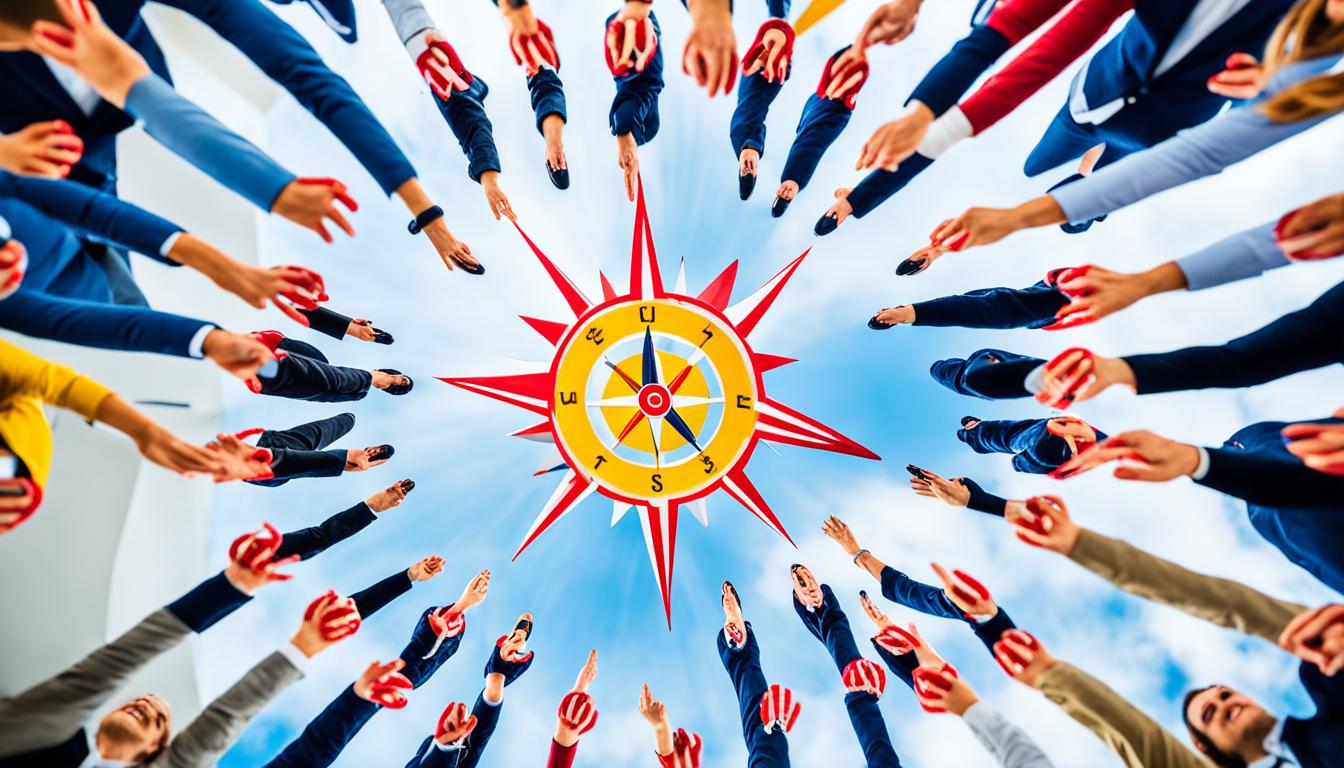As a team dynamics owner, your role extends beyond simply managing a team. It is your responsibility to foster effective collaboration, enhance productivity, and drive success. To achieve this, you must continuously develop and refine your leadership skills. By becoming a proficient team leader, you can create an environment that promotes innovation, encourages open communication, and ensures optimal performance from every team member.
In this article, we will provide you with valuable insights and expert strategies to enhance your leadership abilities as a team dynamics owner. Whether you are new to this role or seeking to further strengthen your skills, these tips will empower you to navigate the complexities of team dynamics and lead your team to success.
Key Takeaways:
- As a team dynamics owner, honing your leadership skills is crucial for effective team management.
- Understand the dynamics of your team and strive to create an environment that fosters collaboration and productivity.
- Key elements of successful team dynamics include trust, effective communication, clearly defined roles, diversity and inclusion, and constructive conflict resolution.
- Factors such as leadership, organizational culture, personalities, and goals can influence team dynamics.
- Strong team dynamics lead to improved productivity, higher job satisfaction, increased innovation, better decision-making, and employee retention.
Understanding Team Dynamics and the Role of a Team Dynamics Owner
Team dynamics play a crucial role in determining the success of a team. It refers to the interactions and relationships between team members that impact their productivity and performance. As a team dynamics owner, it is your responsibility to understand and manage these dynamics to create a positive and cohesive team environment.
Effective teamwork is essential for achieving collective goals and objectives. When team members collaborate seamlessly, share knowledge and skills, and support one another, the team can achieve remarkable results. Open communication is key to fostering effective teamwork. By encouraging open dialogue and active listening, you can ensure that everyone’s ideas and opinions are heard and valued.
“Teamwork is the ability to work together toward a common vision. The ability to direct individual accomplishments toward organizational objectives. It is the fuel that allows common people to attain uncommon results.” – Andrew Carnegie
Furthermore, establishing clear organizational goals is vital for team dynamics. When team members have a clear understanding of the team’s purpose and objectives, they can align their efforts and work together towards shared goals. Organizational communication plays a crucial role in conveying these goals and objectives to the team. By maintaining transparent and effective communication channels, you can ensure that everyone is on the same page and working towards the same objectives.
Facilitating collaboration is another important aspect of team dynamics. Encouraging team members to share ideas, brainstorm together, and leverage each other’s strengths can lead to innovative solutions and improved performance. Collaboration fosters a sense of camaraderie and collective responsibility, creating a positive team environment.
By nurturing relationships within the team and promoting effective communication and collaboration, you can create a team that is motivated and productive. As a team dynamics owner, your role is to facilitate these dynamics and ensure that the team operates cohesively towards achieving its goals.
| Role of a Team Dynamics Owner: | |
|---|---|
| Nurture positive relationships | Strengthen team dynamics |
| Promote effective communication | Facilitate collaboration |
| Encourage open dialogue | Align team efforts towards shared objectives |
| Set clear organizational goals | Create a positive team environment |
Benefits of Effective Team Dynamics:
- Improved productivity
- Enhanced creativity and innovation
- Better problem-solving and decision-making
- Higher job satisfaction and employee engagement
- Greater employee retention and loyalty
Key Elements of Successful Team Dynamics
Successful team dynamics rely on several key elements that contribute to effective teamwork, trust, communication, and clearly defined roles and responsibilities. By fostering these elements within your team, you can create a collaborative and productive environment that promotes synergy and achieves shared goals.
1. Trust
Trust is the foundation of strong team dynamics. Team members must feel safe and comfortable to express their ideas and opinions without fear of judgment. When trust is established, it builds rapport and encourages open communication, leading to better collaboration and problem-solving.
2. Communication
Effective communication is essential for clear understanding and collaboration within the team. Open and transparent communication encourages the sharing of ideas, feedback, and information, which strengthens team dynamics. Encourage active listening, clear articulation, and the use of appropriate communication channels to ensure everyone is on the same page.
3. Roles and Responsibilities
Each team member should have a clear understanding of their roles and responsibilities within the team. Clearly defining expectations and accountabilities ensures that tasks are allocated effectively and everyone understands their contribution to the team’s objectives. This clarity promotes efficiency, accountability, and a sense of ownership among team members.
4. Diversity and Inclusion
Embracing diversity and including different perspectives and ideas is a vital element of successful team dynamics. By encouraging diversity, teams benefit from a variety of viewpoints, experiences, and expertise. This diversity fosters innovation, creative problem-solving, and a well-rounded approach to project execution.
5. Conflict Resolution
Conflict is inevitable in any team setting. However, addressing and resolving conflicts constructively is essential for maintaining positive team dynamics. Encourage open and respectful communication during conflicts, actively listen to all parties involved, and facilitate win-win solutions. By viewing conflicts as opportunities for growth and learning, teams can develop stronger connections and improve their overall performance.

“Effective teamwork requires diverse skills, open communication, trust, and a shared focus on goals and objectives.”
Factors Influencing Team Dynamics
Several factors can influence team dynamics:
- Leadership: Effective leadership plays a crucial role in shaping team dynamics. Leaders must set the tone, provide guidance, and foster a positive team culture.
- Organizational Culture: The overall culture and values of the organization can impact team dynamics. A supportive and inclusive culture promotes collaboration and teamwork.
- Personalities: Individual personalities within the team can affect how team members interact and collaborate. Understanding and managing different personalities can help create a positive and productive team environment.
- Goals and Objectives: Clear and well-defined goals and objectives provide direction and purpose for the team, contributing to positive team dynamics.
To illustrate the significance of these factors in team dynamics, consider the following example:
“At XYZ Corporation, the team dynamics were greatly influenced by the leadership style of John Adams, the team dynamics owner. His collaborative and inclusive leadership approach encouraged open communication and fostered a sense of trust among team members, resulting in a highly cohesive team. Furthermore, the organizational culture at XYZ Corporation prioritized teamwork and embraced diversity, enabling team members to freely share ideas and collaborate effectively. Additionally, the team consisted of individuals with diverse personalities, which brought different perspectives to the table and enriched the team’s problem-solving abilities. Goals and objectives were clearly defined, providing team members with a shared purpose and direction. As a result, the team at XYZ Corporation was able to achieve their goals with high levels of productivity and satisfaction.”
Understanding and managing these factors is essential for team dynamics owners to create a positive and productive team environment.

Factors Influencing Team Dynamics
| Factors | Description |
|---|---|
| Leadership | Effective leadership shapes team dynamics by setting the tone, providing guidance, and fostering a positive team culture. |
| Organizational Culture | The overall culture and values of the organization influence team dynamics, with a supportive and inclusive culture promoting collaboration and teamwork. |
| Personalities | Individual personalities within the team affect how team members interact and collaborate, necessitating an understanding and management of different personalities. |
| Goals and Objectives | Clear and well-defined goals and objectives provide direction and purpose for the team, contributing to positive team dynamics. |
Benefits of Strong Team Dynamics
Strong team dynamics play a vital role in creating a collaborative and productive work environment. When teams work cohesively, it results in numerous benefits that positively impact the overall performance and success of the organization.
- Improved Productivity: Teams with strong dynamics work more efficiently and effectively, leading to improved productivity. When team members trust and support each other, they can accomplish tasks more smoothly and meet project deadlines with ease.
- Higher Job Satisfaction: Positive relationships and a collaborative work environment are key components of strong team dynamics. When team members feel valued, heard, and respected, it enhances their job satisfaction and engagement. This, in turn, leads to higher retention rates and a more positive workplace culture.
- Increased Innovation: Strong team dynamics foster diverse perspectives and encourage creativity. Collaboration and open communication within the team create an environment where unique ideas are shared, leading to increased innovation and out-of-the-box thinking.
- Better Decision-making: When team members collaborate and communicate effectively, they make more informed and thoughtful decisions. The collective expertise and varied viewpoints contribute to comprehensive analysis, minimizing biases and errors in decision-making processes.
- Employee Retention: Positive team dynamics contribute to a supportive and engaging work environment, reinforcing employee satisfaction and retention. When team members feel connected, supported, and recognized, they are more likely to stay committed to the organization.
“Strong team dynamics are the driving force behind successful organizations. It is the synergy between team members that fuels productivity, creativity, and overall team performance.”
Investing in building and maintaining strong team dynamics is essential for organizations seeking to achieve their goals and create a positive work culture.
| Benefits of Strong Team Dynamics |
|---|
| Improved Productivity |
| Higher Job Satisfaction |
| Increased Innovation |
| Better Decision-making |
| Employee Retention |
Strategies for Enhancing Team Dynamics and Leadership Skills
To enhance team dynamics and strengthen your leadership skills, consider implementing the following strategies:
- Foster Open Communication: Encourage open and honest communication within the team, ensuring that everyone’s voice is heard and valued.
- Build Trust: Focus on building trust and creating a safe environment for team members to express their ideas and opinions.
- Promote Collaboration: Implement team-building activities and projects that encourage collaboration and teamwork.
- Develop Conflict Resolution Skills: Provide training and resources to help team members effectively resolve conflicts and manage disagreements.
- Motivate and Inspire: Recognize and appreciate the contributions of team members and provide incentives to keep motivation levels high.
To enhance team dynamics and strengthen your leadership skills, it is essential to foster open communication, build trust, promote collaboration, develop conflict resolution skills, and motivate and inspire your team members. These strategies will help create a positive and productive team environment, where individuals can thrive and excel.
Conclusion
Developing strong leadership skills and fostering effective teamwork as a team dynamics owner is vital for achieving success. By comprehending the essential elements of team dynamics and implementing strategies to enhance communication and collaboration, you can create an environment that promotes productivity, innovation, and a sense of unity. Invest in your leadership development and adapt your approach based on the unique dynamics of your team and organization. With the right skills and strategies, you can become a highly effective team dynamics owner, driving your team towards success.
Remember that effective leadership starts with understanding and managing team dynamics. By building trust, encouraging open communication, promoting collaboration, and resolving conflicts constructively, you are laying the foundation for a cohesive and high-performing team. Additionally, recognizing the benefits of strong team dynamics, such as improved productivity, higher job satisfaction, increased innovation, better decision-making, and enhanced employee retention, reinforces the value of investing in cultivating a positive and collaborative team environment.
As a team dynamics owner, you play a pivotal role in shaping the culture and dynamics of your team. Continuously seek opportunities to refine your leadership skills and stay updated with industry best practices. Remember, effective teamwork and group collaboration are not only essential for achieving organizational goals but also play a significant role in individual and team growth. By implementing the strategies outlined in this article and staying committed to developing your leadership skills, you can create a dynamic and successful team that thrives in today’s collaborative work environments.
FAQ
What is team dynamics?
Team dynamics refers to the interactions and relationships between team members that impact their productivity and performance.
What is the role of a team dynamics owner?
As a team dynamics owner, your role is to understand and manage the dynamics of your team to create a positive and cohesive team environment.
What are the key elements of successful team dynamics?
The key elements include trust, effective communication, clear roles and responsibilities, diversity and inclusion, and conflict resolution.
What factors influence team dynamics?
Factors such as leadership, organizational culture, individual personalities, and goals and objectives can influence team dynamics.
What are the benefits of strong team dynamics?
Benefits include improved productivity, higher job satisfaction, increased innovation, better decision-making, and higher employee retention rates.
How can I enhance team dynamics and leadership skills?
Strategies include fostering open communication, building trust, promoting collaboration, developing conflict resolution skills, and motivating and inspiring team members.
Why is developing leadership skills important for a team dynamics owner?
Developing leadership skills is crucial for effectively managing and leading your team towards success.
How can team dynamics contribute to effective teamwork?
Team dynamics, when effectively managed, create an environment that promotes teamwork, innovation, and productivity.


